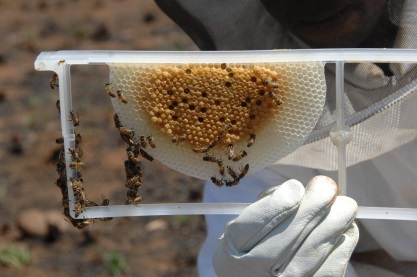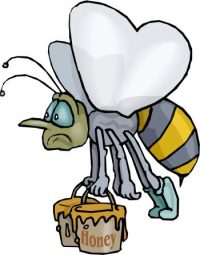Killer bees. You must have heard of them and want to know which is the best defense against killer bees, or where are they located right now.
Because there is, indeed, an invasion going on at this moment.
Killer bees are just another chapter of the story “Stupid things that humans did to the planet and themselves!”
Never ask “why”. The answer is always the same: greed.
The killer bees are a very popular subject these days, and for a good reason. It sounds a little like The Revenge of the Bees! Because we have killed so many of them with our pesticides and radiations, that now the nature comes to pay back. And guess what, it uses the very weapons we, humans, have created.
Because these killer bees are a species WE HAVE CREATED. As always, this is what happens when we think we are smarter than nature and our planet. But I’ll explain it more in detail.
The Africanized bees. Aka the Killer Bees.
 While this picture does make the Africanized bee look much darker than the European bee, there isn’t really much difference between them. To be sure we must measure and compare like 20 different structures, all done in a laboratory. Or check their DNA and enzymes.
While this picture does make the Africanized bee look much darker than the European bee, there isn’t really much difference between them. To be sure we must measure and compare like 20 different structures, all done in a laboratory. Or check their DNA and enzymes.
While we are tempted to think this, these killer bees are not huge insects. They are only ¾ inches long, just like regular bees. Even more, European bees tend to be larger than Africanized ones. But their colonies are larger than the European bees’, like up to 80 000 members.
So, let’s see how we invented them.
We wanted more honey!
The biologist Warwick E. Kerr, interbred honey bees from Europe and southern Africa. Kerr wanted to breed a strain of bees that would produce more honey and be better adapted to tropical conditions than the European strain of honey bee, currently in use throughout North, Central and South America.
His hives were held at his apiary near Rio Claro, São Paulo, in the southeast of Brazil. The hives had been fitted with special excluder screens (called queen excluders) to prevent the larger queen bees and drones from getting out and mating with the local population of European bees.
But, in October 1957 a visiting beekeeper, noticing that the queen excluders were interfering with the worker bees movement, removed them resulting in the accidental release of 26 Tanganyikan swarms of Apis mellifera scutellata – aka Africanized bees or killer bees.
So it was first greed and then accident. The Africanized swarms spread out and cross-bred with local European colonies. Since then their descendants have spread throughout South America, Central America, and eastern Mexico, progressing like 100 to 200 miles per year. This rapid invasion brought the Africanized bee the reputation of one of the most successful biologically invasive species of all time.
If we keep a history, the killer bees arrived in southern Texas in 1990, in Arizona in 1993 and in California in 1995.
Be careful!
- The killer bees are more easily provoked. Their reaction to disturbances is ten times faster than of European honey bees! Perfume, piece of shiny jewelry, dark cloths and loud sounds can agitate killer bees and initiate attack.
- While they are not expert flyers, they can chase you for a longer time than a regular bee does, at least for a quarter of mile.
- Beekeepers avoid them. But they do create nests in the holes in the ground. Old tires, junk piles, building eaves, cement blocks, upturned flower pots and even empty soda cans have been occupied by the bees, according to the U.S. Department of Agriculture. Destruction of their nests triggers the bees’ anger. Do not make them angry!
- The killer bees’ venom is as strong as European bees’.
- The killer bees sting faster than the European ones, in only 3 seconds. Their stinger looks the same at both species. After stinging, both bees releases a chemical substance that smells like ripe banana. That chemical alerts other members of the colony and triggers collective attack.
- Killer bees remains agitated 24 hours after the attack.
Do they produce that much honey, as we wanted in the first place?
Even less. 5 times less honey than European bees produce.

Have the killer bees actually killed anyone?
Unfortunately this is why they got this name: there are at least 1000 deaths reported.
On June 03, 2013, the LiveScience reported the case of a Texas man, who died after being attacked by a swarm of Africanized honeybees, the killer bees. Larry Goodwin, 62 years old, was driving a tractor near his home south of Waco when he disturbed a pile of wood that contained a hive of the notoriously aggressive bees.
What shall we do if we are attacked by killer bees?
 RUN!
RUN!
This is the best advice ever. Forget pride or any other stuff you got there, just run following the straight path, for at least quarter of a mile (more than 400 m). Don’t stop, don’t look back.
Do not hide into the water. They are smart enough to stay there and wait for you to get out. So don’t play Winnie the Pooh with them! Remember you are running for your life!
Run toward an enclosed area like a car or building; even though some bees will follow, most of them will be shut out. Protect your face and head as much as possible from stings by covering your head with a shirt or jacket.
Can we recognize them as being killer bees and thus start running?
No, we cannot. Only that they attack in swarms. Never alone. So, if there is only one bee buzzing around you, it’s probably not a killer bee.
“In a hive of ordinary European bees, about 10 percent will attack if the hive is threatened, but with African bees, all of them attack you.” says Allen Miller, owner of Bees Be Gone.
In the case of the Texas man, Goodwin, the family members told KCENTV.com that there was no part of his body that was not covered in bee stings.
They usually attack outdoors, but there have been some cases where they attacked people at their homes. But there have been cases with European honey bees acting the same. See a case described here.
How many stings kill a person?
If the person is allergic to bees, than 1 sting is fatal.
An average adult can tolerate 1000 stings, but a child can be killed by less than 500. Some experts consider an average of 8 to 10 stings per pound of body weight (almost 0.45 kg) to be fatal.
As for the killer bees’ stings, victims report receiving ten times more stings than from the European bees.
Recommended reading: How to treat a bee sting
Should we expect a global invasion?
Some scientists say “no”, because Africanized honey bees like only worm tropical places and will not go into cold places. They cannot survive a cold winter, and they seem to dislike steady, year-long rainfall. “Rainfall over 55 inches, distributed evenly throughout the year, is almost a complete barrier to [Africanized honey bee] spread,” entomologist José D. Villa of the Honey Bee Breeding, Genetics and Physiology Research Unit in Baton Rouge, La., told Agricultural Research magazine.
But other scientists have proved, in laboratory, that Africanized bees can adapt to cold places. (see in the video below).
So the plausible answer can be a “yes, it is possible.”
According to the study conducted by biologists at UC San Diego, at this moment more than 60 percent of the foraging honey bees in San Diego County are Africanized and they can now be found as far north as California’s delta region.
“Our study shows that the large majority of bees one encounters in San Diego County are Africanized and that most of the bees you encounter are from feral colonies, not managed hives,” said Joshua Kohn, a professor of biology at UC San Diego who headed the study.”
Joshua Kohn, the professor of biology at UC San Diego, who headed the study, says that while the southern range of the bees has stabilized in Argentina, the northward expansion is still ongoing. He and his team found Africanized genetic traits in honey bees as far north as 40 kilometers south of Sacramento in the state’s central valley. From the bees they collected in San Diego, they also discovered that more than 60 percent of foraging honey bee workers have Africanized genetic traits, but that African traits are found in only 13 percent of managed or commercial hives.
Scientists estimate that Africanized bees are capable of expanding their range by as much as 300 to 500 kilometers per year. But because the UC San Diego biologists found Africanized bees only 250 kilometers from their northernmost limit in 2006, they concluded that Africanized bees’ expansion rate in California has slowed considerably. This is good news, as it means that the killer bees have reached their northernmost temperature limits. Yet, with the global worming we cannot tell for sure.
How are killer bees affecting honey production and pollination?
Of course there are major concerns about this, because the honey industry brings an annual value of $140 million dollars and general pollination of orchards and field crops is also important as these bring an annual value of 10 billion dollars.
Africanized honey bees may differ in pollination efforts, be more aggressive, excessively abandon the nest, and not survive the winters (though yet not confirmed, as they didn’t reach a place with winter). It is expected that the beekeepers will not continue their business of honey production, if faced with aggressive bees.
Can’t we do anything to stop them?
The authorities in the US have been working on this problem. And they have come with 2 solutions:
1. The drone-flooding, which means maintaining large numbers of common Honey Bees (the European type) in areas where commercially-reared queen bees mate. This process would limit the mating possibilities between Africanized drones and European queens.
2. Frequent requeening. The beekeeper must replace the queen of the colony, thus assuring that the queens are European honey bees and that mating has also occurred with European drones.
Now, if you are not scared enough, please watch this video. With the risk of ending up hating a sweet movie like “The life of a bee”, or even worse, never eating honey again.
But I think it is better if we know. This way we should refrain ourselves from playing smart scientists, and mostly, learn how to avoid these monsters.
And here is one small good thing about these bees:
As expected, the Africanized bees have considerable resistance to the mites, unlike native honeybees. This mites, especially the Varroa mites, are considered to be implicated in colony collapse disorder, but as the killer bees are resistent to them, maybe the researchers can do a good thing this time, and isolate the trait that gives the Africanized bees their resistance, thus being able to save native honeybee populations.
|
|
References and picture credits:
– http://www.si.edu/encyclopedia_si/nmnh/buginfo/killbee.htm
– http://www.livescience.com/37094-man-dies-in-killer-bee-attack-africanized-honey-bees.html
– http://www.newsroomamerica.com/story/517666/africanized_bees_continue_to_spread_in_california.html
– https://en.wikipedia.org/wiki/Africanized_bee
– “Apis mellifera scutellata” by Jeffrey W. Lotz, Florida Department of Agriculture and Consumer Services, Bugwood.org – http://www.insectimages.org/browse/detail.cfm?imgnum=5196086. Licensed under CC BY 3.0 via Wikimedia Commons
– Africanized and European honey bees – picture credit Scott Bauer, USDA Agricultural Research Service, published under CC on wikimedia commons.
– African Honey Bee Afri-frame.jpg – picture credit Guy Stubbs, published under CC on wikimedia commons



